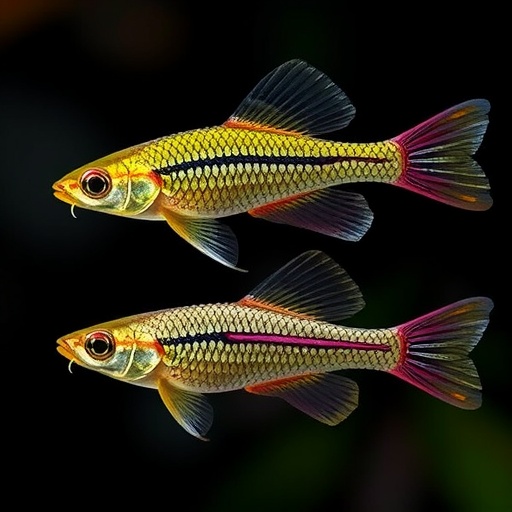In an intriguing advance within the field of evolutionary genetics, researchers L.C. Pettrich and AM Waldvogel have unveiled findings surrounding the intricate dynamics between recombination landscapes and transposable elements in European populations of the non-biting midge, Chironomus riparius. This study, set to be published in BMC Genomics, presents groundbreaking insights that have far-reaching implications for our understanding of genetic diversity and adaptability in response to environmental pressures.
The study focuses on the unique features of the recombination landscape, which refers to the uneven distribution of genetic recombination across different chromosomal regions. Such landscapes are crucial for maintaining genetic diversity, a key component of natural selection and, ultimately, evolutionary success. The researchers employed sophisticated genomic techniques to analyze the recombination rates across multiple populations of Chironomus riparius, providing a comprehensive overview of how these rates are influenced by various environmental factors.
Transposable elements, often referred to as “jumping genes,” play a pivotal role in genetic variation and evolution. Their ability to move around the genome can introduce new genetic material, alter gene expression, and even create novel traits. Pettrich and Waldvogel’s research highlights how these elements interact with the recombination landscape, demonstrating that transposable elements may modulate recombination rates, which in turn can lead to significant shifts in population genetics.
Through the analysis of DNA sequences obtained from diverse populations, the researchers noted distinct patterns of recombination that correlate with the presence of specific transposable elements. These findings suggest that the evolutionary trajectory of Chironomus riparius is deeply intertwined with the mobility of these genetic elements. By facilitating recombination in advantageous regions of the genome, transposable elements may enhance the adaptive potential of these populations in changing environments.
Understanding these complex interactions is essential for evolutionary biologists and conservation geneticists, especially in the context of predicting how organisms might adapt to rapid environmental changes, such as those induced by climate change and anthropogenic factors. Genomic analysis provides a window into the adaptive mechanisms that can sustain populations long-term, making Pettrich and Waldvogel’s findings particularly timely and relevant.
The researchers utilized advanced bioinformatics tools and statistical models to dissect the genomic data. This approach allows for a comprehensive view of both the genomic architecture of Chironomus riparius and the evolutionary implications of the recombination landscape. The study also emphasizes the significance of integrating both ecological data and genomic information to access a holistic understanding of evolutionary processes.
Additionally, this research has implications beyond Chironomus riparius; it sets a precedent for exploring recombination and transposable element interactions in other species. By establishing a model for understanding these dynamics, the findings could pave the way for future studies investigating genetic diversity in various taxa, particularly in the context of environmental stressors.
The implications of this study extend into applications concerning biodiversity conservation and agricultural practices, especially in regions where Chironomus riparius serves as an indicator species for water quality. The ability to understand how genetic diversity is shaped can inform conservation strategies aimed at preserving resilient populations amidst ongoing environmental degradation.
Furthermore, the methodology employed by Pettrich and Waldvogel may be applied to other transposable elements beyond those studied, opening a new avenue in genetic research that could significantly enhance our knowledge of genome evolution and functionality across different organisms.
The findings contribute significantly to the burgeoning field of epigenetics, whereby underlying genetic mechanisms are recognized for their role in influencing phenotypic expression and adaptability. With notable interest in how epigenetic modifications can affect trait expression without altering the underlying DNA sequence, this research highlights the potential for transposable elements to act as agents of adaptation.
As the study suggests, such interactions may very well have immediate applications in genetic engineering and synthetic biology, where harnessing the mechanisms of transposable elements could lead to innovative solutions for crop resilience and sustainability.
In conclusion, Pettrich and Waldvogel’s research offers a profound insight into the mechanisms that drive genetic diversity and adaptability in Chironomus riparius. Their findings underscore the importance of studying the interplay of genomic components in evolutionary biology, contributing significantly to our comprehension of how life adapts and thrives amid constant environmental shifts.
The implications of this research are both wide-reaching and crucial. With ongoing concerns regarding biodiversity loss and climate impacts on ecosystems, understanding the genetic foundations of adaptability may prove vital in informing future ecological and conservation strategies. In a world facing unprecedented environmental changes, studies like this illuminate the resilience of life and the intricate mechanisms that underpin survival and adaptation.
The interplay delineated between recombination landscapes and transposable elements not only enriches our understanding of evolutionary biology but also provides a framework upon which future genomic studies can ideally build, highlighting the endless possibilities that lie within the vast realm of genetic exploration. This research signifies an essential step forward in unearthing the complexity of genomic evolution, providing a blueprint for the multifaceted dialogues between genetics and the environment.
Subject of Research: The interplay of recombination landscape and transposable elements in European populations of Chironomus riparius.
Article Title: Pettrich, L.C., Waldvogel, AM. The interplay of recombination landscape and a transposable element in European populations of Chironomus riparius.
Article References:
Pettrich, L.C., Waldvogel, AM. The interplay of recombination landscape and a transposable element in European populations of Chironomus riparius.
BMC Genomics 26, 1002 (2025). https://doi.org/10.1186/s12864-025-12130-7
Image Credits: AI Generated
DOI: https://doi.org/10.1186/s12864-025-12130-7
Keywords: Genetic Diversity, Recombination Landscape, Transposable Elements, Evolutionary Biology, Chironomus riparius, Genomic Analysis, Adaptation, Environmental Change, Biodiversity Conservation.




